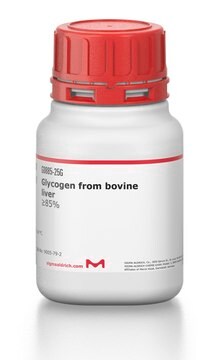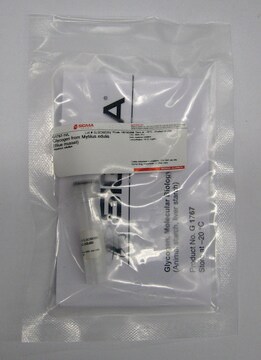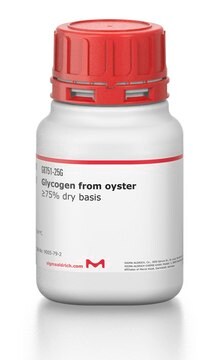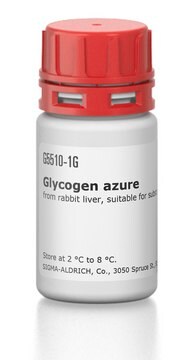10901393001
Roche
Glycogen
from mussels
Synonym(s):
Glycogen, glycogen
Sign Into View Organizational & Contract Pricing
All Photos(1)
About This Item
UNSPSC Code:
41116100
Recommended Products
Quality Level
form
solution
packaging
pkg of 1 mL (20 mg)
manufacturer/tradename
Roche
storage temp.
−20°C
Application
This preparation is used as a carrier for the precipitation of nucleic acids (DNA or RNA). As an inert material it may replace tRNAs or sonicated DNAs.
20 μg glycogen (1 μl solution) allow to precipitate pg-amounts of DNA or RNA from a volume of 1 ml.
In a typical experiment 5 pg [3H]-labeled calf thymus DNA were dissolved in 500 μl 10 mM Tris-HCl, pH 8.0; 1 mM EDTA; 0.4 M LiCl. 1μl glycogen solution (20 μg glycogen) as carrier was added and then precipitated with 1.2 ml ethanol at -15 to -25 °C and stored for 3 hours at -15 to -25 °C. After centrifugation (10 minutes at 12 000 × g) the total radioactivity was found in the precipitate. Without addition of glycogen no precipitation of DNA occured.
20 μg glycogen (1 μl solution) allow to precipitate pg-amounts of DNA or RNA from a volume of 1 ml.
In a typical experiment 5 pg [3H]-labeled calf thymus DNA were dissolved in 500 μl 10 mM Tris-HCl, pH 8.0; 1 mM EDTA; 0.4 M LiCl. 1μl glycogen solution (20 μg glycogen) as carrier was added and then precipitated with 1.2 ml ethanol at -15 to -25 °C and stored for 3 hours at -15 to -25 °C. After centrifugation (10 minutes at 12 000 × g) the total radioactivity was found in the precipitate. Without addition of glycogen no precipitation of DNA occured.
Features and Benefits
Glycogen, in special quality for molecular biology, is an inert carrier in nucleic acid preparations.
Contents
Aqueous solution, 20 mg/ml
Contents
Aqueous solution, 20 mg/ml
Quality
Tested for absence of endonucleases, nicking activity, exonucleases, RNases, nucleic acids, and proteases according to the current Quality Control procedures.
Other Notes
For life science research only. Not for use in diagnostic procedures.
also commonly purchased with this product
Storage Class Code
12 - Non Combustible Liquids
WGK
nwg
Flash Point(F)
does not flash
Flash Point(C)
does not flash
Choose from one of the most recent versions:
Already Own This Product?
Find documentation for the products that you have recently purchased in the Document Library.
Customers Also Viewed
Ming Wang et al.
Aging cell, 19(6), e13147-e13147 (2020-05-01)
Progerin accumulation disrupts nuclear lamina integrity and causes nuclear structure abnormalities, leading to premature aging, that is, Hutchinson-Gilford progeria syndrome (HGPS). The roles of nuclear subcompartments, such as PML nuclear bodies (PML NBs), in HGPS pathogenesis, are unclear. Here, we
Masaoki Ito et al.
JTO clinical and research reports, 1(4), 100084-100084 (2020-08-21)
EGFR mutation-positive lung adenocarcinoma (LUAD) displays impaired phosphorylation of ERK and Src-homology 2 domain-containing phosphatase 2 (SHP2) in comparison with EGFR wild-type LUADs. We hypothesize that SHP2 expression could be predictive in patients positive with resected EGFR mutation versus patients
Hanwen Gu et al.
Poultry science, 100(9), 101321-101321 (2021-07-24)
Deep sequencing of RNAs has greatly aided the study of the transcriptome, enabling comprehensive gene expression profiling and the identification of novel transcripts. While messenger RNAs (mRNAs) are of the greatest interest in gene expression studies as they encode for
Gabriele Girelli et al.
Nature biotechnology, 38(10), 1184-1193 (2020-05-27)
With the exception of lamina-associated domains, the radial organization of chromatin in mammalian cells remains largely unexplored. Here we describe genomic loci positioning by sequencing (GPSeq), a genome-wide method for inferring distances to the nuclear lamina all along the nuclear
Xiwen Cheng et al.
The Journal of biological chemistry, 288(41), 29746-29759 (2013-08-30)
The promyelocytic leukemia protein is a well known tumor suppressor, but its role in metabolism is largely unknown. Mice with a deletion in the gene for PML (KO mice) exhibit altered gene expression in liver, adipose tissue, and skeletal muscle
Our team of scientists has experience in all areas of research including Life Science, Material Science, Chemical Synthesis, Chromatography, Analytical and many others.
Contact Technical Service











